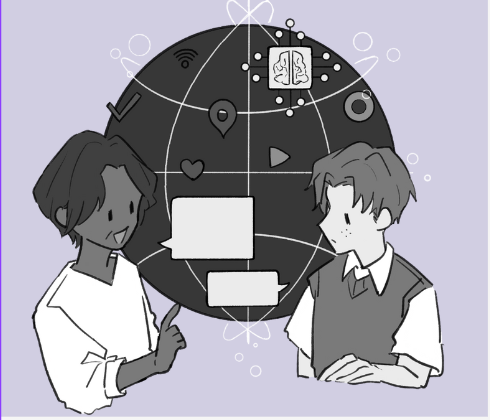
This blog is part of a series on ‘New Proposals for Digital Pedagogies’ that launches the Sussex Digital Pedagogies Toolkit.
This toolkit conceptualises new ways to think through digital teaching and learning, gathering data from members of the University of Sussex community who shared their thoughts, fears and hopes about digital pedagogy. This toolkit has been created collaboratively by a staff-student research team and uses material from a series of online workshops with members of the Sussex community, including faculty, professional services and students. Those who took part will be introduced as ‘participants’ to emphasise their active participation in knowledge production for this project.
In order to gain a mutually understood definition of digital pedagogy, we asked participants to choose their preferred definition. Surprisingly, all participants agreed on one definition of digital pedagogy:
A technique for working and learning with technologies, generating new, flexible, rich, quality learning experiences.
(Dangwal & Srivastava, 2016)
The importance of digital pedagogies lies in creating innovative digital learning frameworks and enhancing teachers’ digital competencies to provide interactive and meaningful learning experiences. This post will explore the challenges and proposals for teaching and learning with technologies in relation to teacher practice, as well as some questions for reflection and resources to explore these ideas further.
Teachers should have ‘that magical blend of humility and authority.’
Workshop participant
Challenges in Teacher Practice
Discussions amongst participants took place on the role of a teacher as a ‘facilitator’ or ‘curator’ to de-emphasise any hierarchical position over learners as passive recipients of knowledge (Friere, 1970; Castrillo, 2014). Some participants, however, reflected that ‘not all teachers are made equal’ in which a teacher’s humanness is not automatically assumed, with evidence suggesting that students see white men as having more authority (hooks, 1994). Participants note that those who teach critical race studies or gender studies are those most likely to receive complaints from students. The pressures of working in Higher Education (HE) were shared, with people feeling they didn’t have time to reflect upon their teaching practice or explore the possibilities of new technologies.
Participants shared that, when learning about something, a teacher who is interested in their subject gets them ‘excited’ and ‘passionate’ and makes them want to learn. Building more personal relationships with students by sharing their background or experiences was generally preferred (Henry and Thorsen, 2018), although some felt like teachers could have ‘main character syndrome’ if they showed off, made excuses for being unprepared or shared things that went off-topic! It is a difficult balancing act between a teacher taking up too much space and not taking up enough, especially in online distance learning (ODL) contexts where students share a desire for more teaching presence. Generally, participants shared a preference for a more personal touch and connection to their teacher in online and in-person contexts.
Proposals for Teacher Practice
It was important for participants that teachers be flexible and recognise when learners are struggling to keep up and adapt accordingly. Teachers were commended for being able to frame learning in-relation, both to real-world scenarios and to the learning objectives and assessments. A teacher being knowledgeable but ‘confident to say when they don’t know the answer to a question’ breeds trust and reflects human fallibility.
Knowing and demonstrating how learners are assessed using digital technology was highlighted as promoting transparency in the expectations of the course and the kinds of support that the teacher will provide. Giving appropriate, supportive feedback – either verbally or via digital means – at regular intervals against the learning objectives was recognised as very important. Participants discussed making assessments more personal and creative to think outside the box of conventional ways of teaching and assessing.
Questions and Resources
- How might you share personal experiences, and passion for the topic?
- How could you reflect upon digital pedagogical practice with other teachers and students?
- How can you set – and reassess – boundaries and expectations?
- How might you embed flexibility?
- How faculty can map their own boundaries
- The transformative potential of creative assignments in higher education
Read the full toolkit:
References
Castrillo de Larreta-Azelain, M. D., (2014). ‘Language teaching in MOOCs: The integral role of the instructor’ in E. Martín-Monje, & E. Bárcena, (Eds.), Language MOOCs. Providing Learning, Transcending Boundaries, Berlin: De Gruyter Open, pp. 67-90.
Dangwal, K. L., & Srivastava, S., (2016). ‘Emotional maturity of internet users’ Universal Journal of Educational Research, 4(1), pp. 6–11. https://doi.org/10.13189/ujer.2016.040102.
Friere, P., (1970) Pedagogy of the Oppressed, London and New York: Continuum.
Henry, A. and Thorsen, C., (2018) ‘Teachers’ self-disclosures and influences on students’ motivation: A relational perspective’, International Journal of Bilingual Education and Bilingualism, 24(1), 1–15. https://doi.org/10.1080/13670050.2018.1441261.
hooks, b., (1994) Teaching to Transgress: Education as the Practice of Freedom, Oxon: Routledge.


Leave a Reply